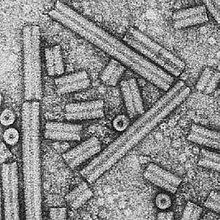Tobacco rattle virus
| Tobacco rattle virus (TRV) | |
|---|---|
 |
|
| Electron micrograph of TRV particles in two types | |
| Virus classification | |
| Group: | Group IV ((+)ssRNA) |
| Order: | Unassigned |
| Family: | Virgaviridae |
| Genus: | Tobravirus |
| Species: | Tobacco rattle virus |
| Synonyms | |
|
|
Tobacco rattle virus (TRV) is a pathogenic plant virus. Over 400 species of plants from 50 families are susceptible to infection.
The virus causes the plant disease tobacco rattle in many plants, including many ornamental flowers including Narcissus. It causes the disease corky ringspot in potatoes. The disease manifests in various ways, and signs can include brown rings and arcs on the surface of a potato, and discolored spots on the interior.
Nematodes of the family Trichodoridae, the stubby-root nematodes, are vectors of the virus. The nematode species Paratrichodorus minor, for example, introduces the virus when it feeds on the roots of plants. The virus can also be spread on garden tools. It can also be mechanically and seed transmitted.
Boning first discovered Tobacco Rattle Virus in 1931 in Germany. It was discovered in Nicotiana tabacum, which is a species of cultivated tobacco.
Tobacco Rattle Virus is common and potentially serious in a variety of herbaceous ornamentals including, but not limited to, astilbe, bleeding heart, coral bells, daffodil, epimedium, gladiolus, hyacinth, marigold, tulip and vinca. Tobacco rattle can also affect vegetable crops such as beans, beets, peppers, potatoes, and spinach. On potatoes, the disease is referred to as corky ring spot. The disease corky ringspot of potatoes was first reported in the United States in 1946, and was identified incorrectly as a novel virus until advances in genetics demonstrated it to be the result of TRV.
Symptoms of Tobacco Rattle Virus vary based on the plant host, which differs widely in this disease. Common symptoms include mottling, cholortic or necrotic local lesion, ringspots or line patterns, and systemic necrosis.
Tobacco Rattle Virus is a Tobravirus on plants. Transmission of Tobravirus is mostly supported by nematodes, such as Trichodorus and Paratrichodorus. These species of nematodes are known as stubby root nematodes. Transmission of the virus is separated into four distinct steps: Acquisition, absorption, retention, and virus particle release. At the beginning of the feeding cycle, the Stubby-Root Nematode punctures multiple individual cells by using its specialized stylet, an onchiostyle. Among those penetrated cells, the nematode select a cell which it will feed on. Upon selection, the nematodes begin sucking up cell contents, leading to death of the cell. During this process, adsorption of Tobravirus begins, the process where cytoplasm of infected cells containing Tobravirus is assimilated into the nematodes. Both juvenile and adult nematodes can pick up Tobravirus particles. Once the Tobravirus has been transferred into the nematodes, the retention portion of the lifecycle begins. Tobravirus consumed by the nematodes could linger in the nematodes for years. Eventually, the nematode loaded with Tobravirus starts its feeding cycle on uninfected root cell. During this period, Tobravirus will be transferred into the new cell, completing the virus transmission.
...
Wikipedia
